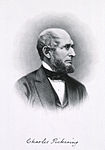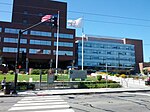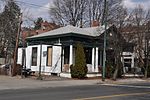Joseph Holmes House
Cambridge, Massachusetts Registered Historic Place stubsHouses completed in 1801Houses on the National Register of Historic Places in Cambridge, Massachusetts

The Joseph Holmes House is an historic house at 144 Coolidge Hill Street in Cambridge, Massachusetts. The 2+1⁄2-story wood-frame house was built in 1801 by John Holmes, father of Joseph Holmes. It was originally located on Appian Way in Harvard Square, and was moved to its present location in 1929, at which time an ell was also added. It is a well-preserved yet unpretentious Federal-style house, a rarity in "Old Cambridge", where such houses were once quite common. This house is not particularly pretentious, with a five-bay facade and center entrance, and is set sideways on its narrow lot.The house was listed on the National Register of Historic Places in 1983.
Excerpt from the Wikipedia article Joseph Holmes House (License: CC BY-SA 3.0, Authors, Images).Joseph Holmes House
Shady Hill Road, Cambridge
Geographical coordinates (GPS) Address Nearby Places Show on map
Geographical coordinates (GPS)
| Latitude | Longitude |
|---|---|
| N 42.371666666667 ° | E -71.14 ° |
Address
Shady Hill Road
Shady Hill Road
02163 Cambridge
Massachusetts, United States
Open on Google Maps










